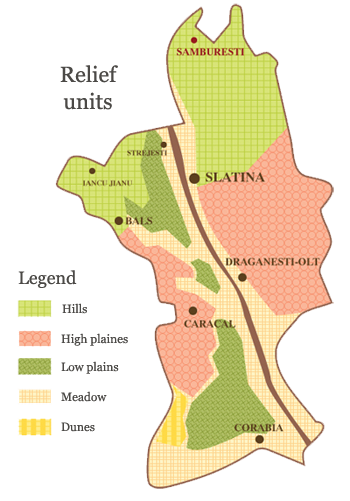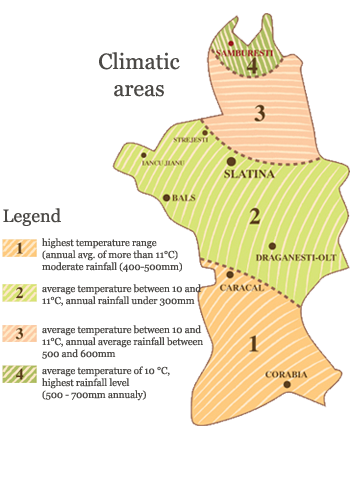 Grape is a special creature: eccentric as a queen and spoiled as a princess. But how could it pass unobserved when the Gods’ liquor is made of it? And Samburesti is the ideal place to fulfil all desires. It finds here the best ground to plunge into and the warmest light to bask in. The River Olt below cools it in the summer heat and the Carpathian Mountains above protect it from malevolent winds.
Grape is a special creature: eccentric as a queen and spoiled as a princess. But how could it pass unobserved when the Gods’ liquor is made of it? And Samburesti is the ideal place to fulfil all desires. It finds here the best ground to plunge into and the warmest light to bask in. The River Olt below cools it in the summer heat and the Carpathian Mountains above protect it from malevolent winds.
The short distance between Samburesti and Dragasani misled specialists into thinking that conditions in the two vineyards were alike. If, from the point of view of climatic conditions, data analyses of the last years confirm it, things are completely different as for the soil. Another factor contributing to the creation of the specific microclimate of the Samburesti vineyard is represented by orography and the display of vine-cultivated areas. As a result of the partnership between the Faculty of Horticulture from the University of Craiova, Oenology Department, and Domeniile Samburesti, a whole series of studies regarding the oenological potential of the area was performed (Maria Enachescu, thesis, Study on the Oenological Potential of the Samburesti Vineyard, Faculty of Horticulture, Craiova, 1999).
The results obtained underlined the exceptional qualities of Samburesti with respect to red wines, especially the Cabernet Sauvignon variety. The ampelographic research farm from Dealu Mare, part of Domeniile Samburesti, studied more than 200 vine varieties, and confirmed the existence of an extraordinary white wine potential.
 The Samburesti vineyard is blessed by its strategic position in the transition area stretching between the Getic hills and the long elevations making up Cotmeanca Piedmont. Even if it’s part of the Getic Plateau, Cotmeanca Piedmont has plane characteristics, presenting a surprising evenness up to the contact line with the Getic Carpathians. Its slopes are thus caressed by the wine-friendly sunlight all the time.
The Samburesti vineyard is blessed by its strategic position in the transition area stretching between the Getic hills and the long elevations making up Cotmeanca Piedmont. Even if it’s part of the Getic Plateau, Cotmeanca Piedmont has plane characteristics, presenting a surprising evenness up to the contact line with the Getic Carpathians. Its slopes are thus caressed by the wine-friendly sunlight all the time.
The Samburesti vineyard is situated in the southern part of the country, at a latitude of 44°48″ north and a longitude of 24°48″ south, 30 km away from the Dragasani vineyard. It holds a favourable position as it covers the transition area between the Getic hills and the long elevations making up the southern half of the Piedmont, which formed in the south of the Meridian Carpathians in the first half of the Quatenary. As for its position within big landforms, Samburesti is part of the Getic Plateau, more precisely of Cotmeana Piedmont, limited by the Olt Valley in the west, the Arges Valley in the east and the Arges Hills in the north.
Cotmeana Piedmont has plane characteristics, presenting a surprising evenness up to the contact line with the Getic Carpathians. The relief of the Piedmont is dominated by medium-sized hills of slight inclines, counting numerous platforms and long valleys. The vine plantations cover the side of Cungrea Mare creek, affluent of the River Olt, having a large south-oriented opening and southwest sunsoaked descents that ensure a perfect climate for grapevine growing. The Samburesti vineyard covers three communes situated in the north of the Olt County: Dobroteasa, Samburesti and Vitomiresti. In Samburesti, grapevines cover the famous hills of Bolindetu, Rosulesti, Petria, Vifura and Grosarea. Here, the Cabernet Sauvignon and Merlot vine varieties give wines of exceptional quality. In Vitomiresti there is Dejesti Farm, whose vineyards cover the platforms and slopes of Vifura and Dejesti hills, another ideal place for red wine varieties. On the territory of the Commune of Dobroteasa there are the farms of Bolovanu and Campu Mare. The Campu Mare Hill is situated at the confluence of Cungrea Mare creek and the River Olt, on the right side of the creek.
 The quality of wine mainly depends on the soil features and Samburesti has been blessed with excellent earths for grapevine growing, not only due to the organic and mineral elements existing in the soil. The boulders caught in the sandy-loamy texture, true energetic reservoirs, capture the day heat and release it by night, letting the grape slowly ripe and increasing its sugar content.
The quality of wine mainly depends on the soil features and Samburesti has been blessed with excellent earths for grapevine growing, not only due to the organic and mineral elements existing in the soil. The boulders caught in the sandy-loamy texture, true energetic reservoirs, capture the day heat and release it by night, letting the grape slowly ripe and increasing its sugar content.
The edaphic factor plays an important role in grapevine growing. The earth of the Samburesti vineyard is mainly composed of clayey illuvial soils and regosols, in a smaller percentage. These soils are characterized by a small-to-medium supply in organic and mineral substances, presenting a variable texture (from sandy-loamy to clay type). The soil reaction is acid to slightly acid. Moreover, the soil is well supplied (78%) in phosphorus pentoxide and highly supplied (97%) with mobile potassium oxide. Vine couldn’t feel better anywhere else.
 Vines don’t like rain, so it rarely rains in Samburesti. But, even if the rainfall during the vegetation period is low, due to the close distance to the Olt Valley and the specific air currents in the area, humidity is maintained at most favourable levels. Weather is on our side.
Vines don’t like rain, so it rarely rains in Samburesti. But, even if the rainfall during the vegetation period is low, due to the close distance to the Olt Valley and the specific air currents in the area, humidity is maintained at most favourable levels. Weather is on our side.
Climatic factors strongly influence the physiological and biochemical processes vine is subject to. Temperature affects growth and fructification processes, both through its level and the sum of the temperature calculated for a given period of time. Together with humidity, it determines the vine botanical habitat and economic cultivation. The annual sum of temperature degrees, calculated for a period of 40 years, amounted to approximately 3856° C, varying between 3640° C and 4295° C, while the average of absolute temperatures was of 15° C. These figures range Samburesti among optimum grapevine growing areas.
Vine is a hellophilous plant, requiring a lot of light as chlorophyll assimilation is much more intense under direct sunlight than in shadow. Thus, grapes are more colourful and acquire higher sugar content. That’s why vine should be cultivated in south-oriented areas, rows following the north-south direction in order to capture the highest quantity of light.
At Samburesti, the average registered for the vegetation periods during the last 20 years reached a value of 1576 hours of exposure to the sun per year. That’s, again, an optimum ranging within grapevine growing limits. In the Olt County, there are four climatic areas:
1. highest temperature range (annual average of more than 11° C); moderate rainfall (400-500mm);
2. average temperatures between 10 and 11° C; annual rainfall under 300mm ;
3. average temperatures between 10 and 11° C; annual average rainfall between 500 and 600mm;
4. average temperature of 10° C; highest rainfall level (500-700mm annually).





